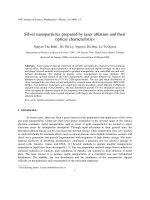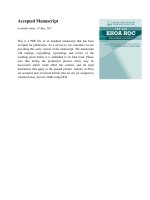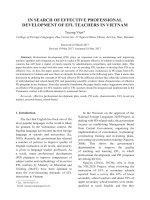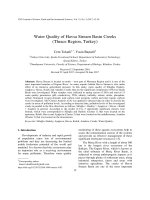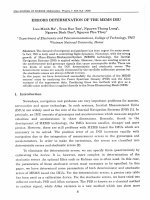DSpace at VNU: Photochemical decoration of silver nanoparticles on graphene oxide nanosheets and their optical characterization
Bạn đang xem bản rút gọn của tài liệu. Xem và tải ngay bản đầy đủ của tài liệu tại đây (1.5 MB, 6 trang )
Journal of Alloys and Compounds 615 (2014) 843–848
Contents lists available at ScienceDirect
Journal of Alloys and Compounds
journal homepage: www.elsevier.com/locate/jalcom
Photochemical decoration of silver nanoparticles on graphene oxide
nanosheets and their optical characterization
Nguyen Thi Lan a, Do Thi Chi a, Ngo Xuan Dinh a, Nguyen Duy Hung a, Hoang Lan a, Pham Anh Tuan b,
Le Hong Thang c, Nguyen Ngoc Trung d, Nguyen Quang Hoa e, Tran Quang Huy f, Nguyen Van Quy g,
Thanh-Tung Duong h, Vu Ngoc Phan a, Anh-Tuan Le a,⇑
a
Department of Nanoscience and Nanotechnology, Advanced Institute for Science and Technology (AIST), Hanoi University of Science and Technology (HUST), No. 1 Dai Co Viet
Street, Hai Ba Trung District, Hanoi, Viet Nam
b
Vietnam Metrology Institute, 08 Hoang Quoc Viet Road, Cau Giay District, Hanoi, Viet Nam
c
School of Materials Science and Engineering, Hanoi University of Science and Technology (HUST), 01 Dai Co Viet Street, Hai Ba Trung District, Hanoi, Viet Nam
d
School of Engineering Physics, Hanoi University of Science and Technology (HUST), 01 Dai Co Viet Street, Hai Ba Trung District, Hanoi, Viet Nam
e
Department of Physics, Hanoi University of Science, 334 Nguyen Trai, Thanh Xuan, Hanoi, Viet Nam
f
Laboratory for Ultrastructure and Bionanotechnology (LUBN), National Institute of Hygiene and Epidemiology (NIHE), No. 1 Yecxanh Street, Hai Ba Trung District, Hanoi, Viet Nam
g
International Training Institute for Materials Science (ITIMS), Hanoi University of Science and Technology (HUST), 01 Dai Co Viet Street, Hai Ba Trung District, Hanoi, Viet Nam
h
Department of Materials Engineering, Chungnam National University, Daeduk Science Town, 305-764 Daejeon, Republic of Korea
a r t i c l e
i n f o
Article history:
Received 24 April 2014
Received in revised form 13 June 2014
Accepted 5 July 2014
Available online 11 July 2014
Keywords:
Ag-GO nanohybrid
Green synthesis
Optical properties
a b s t r a c t
Nanohybrid materials based on silver nanoparticles (Ag-NPs) and graphene oxide (GO) are attracting considerable research interest because of their potential many applications including surface-enhanced
Raman scattering, catalysis, sensors, biomedicine and antimicrobials. In this study, we established a simple and effective method of preparing a finely dispersed Ag-GO aqueous solution using modified Hummer
and photochemical technique. The Ag-NPs formation on GO nanosheets was analyzed by X-ray diffraction, transmission electron microscopy, Raman spectroscopy, and Fourier-transform infrared spectroscopy. The average size of Ag-NPs on the GO nanosheets was approximately 6–7 nm with nearly
uniform size distribution. The Ag-GO nanohybrid also exhibits an adsorption band at 435 nm because
of the presence of Ag-NPs on the GO nanosheets. Photoluminescence emission of the Ag-GO nanohybrid
was found at 400 and 530 nm, which can be attributed to the interaction between the luminescence of
exploited GO nanosheets and localized surface plasmon resonance from metallic Ag-NPs. The observed
excellent optical properties of the as-prepared Ag-GO nanohybrid showed a significant potential for optoelectronics applications.
Ó 2014 Elsevier B.V. All rights reserved.
1. Introduction
Graphene, which consists of a one-atom-thick sheet of sp2bonded carbon atoms in a hexagonal two-dimensional lattice, is
attracting considerable research interests because of its remarkable physicochemical properties. Such properties include a high
specific surface area, mechanical strength, and thermal and electrical conductivities, as well as extraordinary electronic properties
and electron transport capabilities [1]. These excellent properties
make graphene a promising nanomaterial for various technological
applications, ranging from biosensor, energy to optoelectronic
devices [1].
⇑ Corresponding author.
E-mail address: (A.-T. Le).
/>0925-8388/Ó 2014 Elsevier B.V. All rights reserved.
A specific class of graphene research deals with graphene oxide
(GO), GO sheets are chemically synthesized graphene sheets that
are modified with oxygen-containing functional groups. Oxygenated groups in GO can strongly affect the electronic, mechanical,
and electrochemical properties of GO, thereby resulting in differences between GO and pristine graphene. In comparison with the
pristine graphene, the existence of these oxygen functional groups
can also provide advantages such as hydrophilicity and controllable electronic properties for using GO in various technological
applications [2–4].
Silver nanoparticles (Ag-NPs) are attractive objects for the scientific community in materials science because Ag-NPs posses
many advantages such as good conductivity, catalytic and widespectrum antimicrobial activity against various micro-organisms
and localized surface plasmon resonance (LSPR) effect [5,6].
844
N.T. Lan et al. / Journal of Alloys and Compounds 615 (2014) 843–848
To explore the combined advantageous properties of Ag-NPs
and GO sheets, Ag-GO nanohybrids have been intensively studied
[7,8]. The Ag-NPs have an important role in many applications such
as surface-enhanced Raman scattering, catalyst, and sensors, as
well as biomedical and antimicrobial applications. Insertion of
Ag-NPs into the GO nanosheet is important for further exploration
of Ag-NPs properties and applications. For example, Wei et al. [9]
reported that introduction of Ag-NPs into GO sheets indicate that
the antibacterial performance of Ag-GO nanohybrids were
enhanced compared with Ag-NPs and GO materials alone. The
Ag-GO nanohybrids also show non-toxic effect on rat skin [9].
Other reports [10–12] showed excellent antimicrobial activity for
Ag-GO nanohybrids.
To date, several solution-based routes have been developed to
synthesize the Ag-NPs on the GO nanosheets such as microwave
irradiation, hydrogen reduction in supercritical CO2, surfacemodification method using thiol groups, and citrate-modified
chemical reduction, [7–12]. However, some challenges and
problems remain in preparing highly dispersed metallic Ag
nanoparticles of regular size on GO nanosheets and in controlling
stable dispersions of Ag-GO suspension in aqueous solution
because of Ag-GO agglomeration. To overcome this problem, we
introduce a simple and effective method for preparation of
Ag-GO nanohybrids via a two-step process, in which aqueous
dispersions of GO nanosheets are produced using a modified
Hummer technique and the Ag-NPs are then decorated on GO
nanosheets by a photochemical technique.
In this study, we demonstrate an easy synthesis method for
effective decoration of the Ag-NPs on the GO nanosheet using modified Hummer and photochemical techniques. UV irradiation was
used to improve the uniform dispersions of Ag-NPs on the GO
nanosheets during the reduction process by glucose with oleic acid
as a capping agent. The analyzed results suggest that presence of
Ag-NPs on the surface of GO nanosheets and the interaction
between Ag-NPs and functional groups on the edge of the GO
nanosheets were ascribed to the electron transfer from metallic
Ag to the GO nanosheets. Two emission peaks in photoluminescence of Ag-GO nanohybrids were also observed at 400 and
530 nm, which are attributed to the interaction between luminescence of exploited GO nanosheets and localized surface plasmon
resonance from metallic Ag-NPs. Photoluminescence intensity of
Ag-GO nanohybrid increased at peak $400 nm with increasing
concentration of Ag-NPs because of surface plasmon-enhanced
luminescence.
2. Experimental procedures
2.1. Chemicals
Analytical-grade silver nitrate (AgNO3, 99.9%), sodium hydroxide (NaOH),
ammonium hydroxide (NH3, 25%), potassium permanganate (KMnO4, 99.9%),
hydrogen peroxide (H2O2, 30%), sulfuric acid (H2SO4, 98%), hydrochloric acid (HCl,
37%), nitric acid (HNO3, 63%), oleic acid, and glucose that were used in this study
were purchased from Shanghai Chemical Reagent Co. Ltd. Graphite (nature coal
powder) was fabricated from coal in Vietnam.
2.2. Synthesis of graphene oxide (GO) by modified Hummer method
First, GO nanosheets were synthesized from coal powder by modified Hummer
method as described previously [13]. Briefly, 1 g of coal powders were mixed with
HNO3 and KMnO4 at a volume ratio of 1:2:1.5, respectively, and then the mixture
were converted to exploited graphite (EG) under microwave 800 W for 1 min. In
this reaction, the mixture of 2 g of EG, 8 g of KMnO4, and 1 g of NaNO3 was added
slowly to 160 mL of 98% H2SO4 at 5 °C in ice-water bath and then stirred for 30 min.
Ice-water bath was removed, and then temperature was increased slowly to 45 °C
and continuously stirred for 2 h. Deionized water was added slowly to the mixture
which was stirred until purple fumes were inhibited. By increasing reaction temperature to 95 °C and stirring the mixture for 1 h, the resulting product of the GO
nanosheets was obtained with yellow–brown color. The GO nanosheets were then
treated by H2O2 30% and HCl 10% solution to eliminate KMnO4, MnO2, and other
metal ions that remained in the GO solution. The final GO products were purified
by filtering, washing several times by ultrasonic vibration, centrifugation with
deionized water, and removal of ultrafine carbon powder that was not oxidized.
2.3. Synthesis of Ag-GO nanohybrid by modified photochemical method
The Ag-NPs were then deposited on the GO nanosheets by modified Tollens process as reported elsewhere [14]. Fig. 1 shows the schematic of a two-step process to
synthesize the Ag-GO nanohybrid. In a typical experiment, 1.7 g (10 mmol) of
AgNO3 was dissolved in 100 mL of deionized water. The AgNO3 solution was then
precipitated with 0.62 g (15.5 mmol) of sodium hydroxide (Aldrich, >99%). The
obtained precipitate, which is composed of Ag2O, was filtered and dissolved in
100 mL of aqueous ammonia (0.4% w/w, 23 mmol) until a transparent solution of
silver ammonium complex [Ag(NH3)2]+(aq) formed. Up to 2.5 g (8.9 mmol) of oleic
acid was then added dropwise into the complex, and the resulting solution was
gently stirred for 2 h at room temperature until the complete homogeneity of the
reaction mixture was achieved. As to the synthesis of Ag-GO nanohybrid, resulting
complex mixture was mixed with GO suspension (3 mg/mL) while stirring for
30 min and followed by the addition of 2 g (11.1 mmol) of glucose. The reduction
process of the silver complex solution (in quartz glass) was initiated with UV irradiation. A UV lamp (k = 365 nm, 35 W) was used as a light source to stimulate the
reduction process. After 12 h of UV irradiation, the Ag-NPs were deposited on the
GO nanosheets to form the Ag-GO nanohybrid.
2.4. Characterization techniques
Transmission electron microscopy (TEM, JEOL-JEM 1010) was conducted to
determine the morphology and distribution of the Ag-NPs on the GO nanosheets.
The samples for TEM characterization were prepared by placing a drop of colloidal
solution on a formvar-coated copper grid that was dried at room temperature. The
composition of the Ag-GO nanohybrid was characterized by energy-dispersive
X-ray (5410 LV JEOL). The crystalline structure of the prepared Ag-NPs and Ag-GO
nanohybrid was analyzed by X-ray diffraction (XRD, Bruker D5005) using Cu Ka
radiation (k = 0.154 nm) at a step of 0.02° (2h) at room temperature. The background was subtracted using linear interpolation method.
The chemical functional groups of GO and Ag-GO were characterized using FTIR
measurements, samples were collected with one layer coating in potassium bromide and compressed into pellets, and spectra in the range of 400–4000 cmÀ1 were
recorded with Nicolet 6700 FT-IR instrument. Raman measurement was conducted
using 633 nm of HeANe laser excitation.
The UV–vis absorbance spectra were recorded using a HP 8453 spectrophotometer, and the absorption spectrum of all suspension samples in 10 mm path length
quartz cuvettes was 300–900 nm. The photoluminescence spectra of GO, Ag, and
Ag-GO were measured using Nanolog, Horiba. The photoluminescence spectra were
obtained with 300 nm excitation.
3. Results and discussion
3.1. Formation of GO nanosheet and Ag-GO nanohybrid
Fig. 2 shows the TEM images of (a) Ag-NPs and (b–d) Ag-GO
nanohybrids at different magnifications. The Ag-NPs are finely dispersed (Fig. 2a), the average size of the Ag-NPs was $5 nm (see
inset of Fig. 2a). No aggregation of silver particles was also
observed, indicating the important role of UV irradiation for controlling stably uniform dispersions in Ag-NP synthesis process.
Fig. 2b–d clearly show the presence of a large number of Ag-NPs
that are anchored to the GO surfaces. The adhered nanoparticles
have quasi-spherical morphologies and are dispersed uniformly
on the GO nanosheets. In these TEM images, most nanoparticle
diameters are $7 nm (see inset of Fig. 2a). The wrinkles of the
GO nanosheets (Fig. 2c) are also observed, revealing that the GO
nanosheets are thin. Based on TEM analysis, no aggregation of
Ag-NPs is found on the surface of GO nanosheets. The small sizes
and fine dispersions of Ag-NPs on GO nanosheets enable potential
for various technological applications.
The formation of the Ag-NPs on GO nanosheets is further confirmed by XRD analysis. Fig. 3 shows the XRD patterns for GO
nanosheets and GO-Ag nanohybrid samples. The GO nanosheets
exhibited a broad peak at 10.9° corresponding to the (0 0 2) interlayer spacing of 0.81 nm, which indicates that the ordinal structures of graphite have been exploited and that oxygen-containing
functional groups have been inserted into the interspaces. After
N.T. Lan et al. / Journal of Alloys and Compounds 615 (2014) 843–848
845
Fig. 1. A schematic protocol for a two-step process to synthesize the Ag-GO nanohybrid.
Fig. 2. TEM images of (a) Ag-NPs and (b–d) Ag-GO nanohybrids at different magnifications.
decorating the Ag-NPs, three distinct diffraction peaks appear at
2h = 38.2°, 44.4°, and 64.5°, which correspond to the (1 1 1),
(2 0 0), and (2 2 0) crystalline planes of metallic Ag (JCPDS No. 040783). These observations confirm that the metallic Ag-NPs are
effectively anchored to the surface of GO nanosheets. TEM and
XRD analyses revealed that the GO, Ag-NPs, and Ag-decorated GO
nanosheets were formed. These obtained results suggest that the
Ag-NPs are successfully decorated on the GO nanosheets using
two-step process. In the present study, the mechanism for Ag-GO
formation can be understood as follows: after mixing silver
ammonia complex with GO nanosheets, the positively charged
Ag[(NH3)2]+ can be easily attached to the negatively charged oxygen functional groups on the GO. When Ag-GO formation occurs
by adding glucose to the mixture, the aldehyde groups of glucose
release electrons to reduce silver ammonia complex into silver
nanoparticles. The Ag-NPs can be deposited into the GO nanosheets because of the electrostatic interaction between silver
ammonia complex and GO nanosheets. UV irradiation is performed
during the reduction process to control uniform dispersions of
Ag-NPs on the GO nanosheets.
846
N.T. Lan et al. / Journal of Alloys and Compounds 615 (2014) 843–848
Fig. 3. XRD patterns for GO nanosheets and GO-Ag nanohybrid samples.
Fig. 5. Raman spectra of (a) GO and (b) Ag-GO nanohybrids.
On the basis of TEM and XRD studies as well as earlier reports
[15,16], a possible mechanism of silver nanoparticle formation
and growth under the applied experimental conditions was suggested. The UV irradiation causes excitation of [Ag(NH3)2]+ ions followed by electron transfer from the glucose molecule to Ag+, thus
producing Ag0 atoms which then form clusters and seeds:
GO nanosheets [2,3]. However, a noticeable decrease in the intensity of the adsorption bands of the oxygenated functional groups
was found in the FTIR spectrum of the Ag-GO nanohybrid. This
finding results mainly from both presence of the Ag-NPs on the
surface of GO nanosheets and a slight reduction of GO by glucose
during the synthesis process of Ag-GO. The decrease of OAH
stretch absorption intensity in the hybrids is attributed to interactions between silver ions and hydroxyl group of GO. The variation
of the other peak in the case of Ag-GO demonstrates the interaction
between silver ions and oxygen functional groups on both basal
planes (hydroxyl group OH) and edges (carboxyl group CAOH) of
the GO nanosheets through the formation of a coordination bond
or through simple electrostatic attraction. The FTIR results demonstrate that the GO nanosheets have been successfully exfoliated,
and strong interactions may exist between Ag-NPs and the remaining hydroxyl and carboxyl groups on the surface of the GO.
Fig. 5 shows the Raman spectra of (a) GO and (b) Ag-GO nanohybrids. For the case of GO (Fig. 5), two characteristic prominent
peaks were observed at 1360 cmÀ1 (D band) and at 1591 cmÀ1 (G
band). Compared with GO, the Raman spectra of Ag-GO indicates
that the D band and the G band are slightly shifted to 1338 and
1595 cmÀ1, respectively. The D band represents edges, other
defects, and disordered carbon because of vibration of sp3-bonded
carbon atoms and impurities, whereas the G band arises from the
zone center E2g mode, assigning to the ordered sp2-bonded C
atoms. A significant frequency shift (about 22 cmÀ1) toward a
smaller wavenumber of the D-band is found in Ag-GO sample compared with the GO indicating a higher level of disorder of the
graphene layers and increased numbers of defects because of
the partial reduction of GO by glucose during the synthesis of the
Ag-GO nanohybrid. The spectra showed that the carbon framework
of GO is modified by reduction reaction process of Ag-NPs. This
finding is consistent with the FTIR result and that from previous
works [7,10].
Besides, the ratio of intensity of the D band to that of the G band
(ID/IG) also increased. The ID/IG values are approximately 0.77 and
0.92 for GO and GO-Ag respectively. The ratio value of ID/IG represents the degree of disorder and the average size of the sp2
domains. The observed increasing ID/IG-value suggested a decrease
in in-plane size of graphene upon the reduction process. The partial
reduction of GO could cause fragmentation along the reactive sites
and might yield new graphitic domains, leading to smaller sizes
and higher number of graphene than that of GO before the reduction [7,11].
In the present study, the higher increased ID/IG-value of the
Ag-GO nanohybrid than that of the GO is likely attributed to the
surface-enhanced Raman scattering from the intense local electromagnetic fields of Ag-NPs that accompanies plasmon resonance
effect. The FTIR and Raman results suggest that the attachment
hv
_
½AgðNH3 Þ2 þ þ RCHOH ! Ag0 þ 2NH3 þ Hþ þ RCOH
nAg0 ! ðAgn Þ0 ;
where RCHOH represents glucose in cyclic form. The use of UV irradiation leads to the substantially simultaneous formation of a large
amount of silver nuclei which then started to grow. This situation
results in small dimensions and stably uniform dispersions of the
finally obtained silver NPs on the GO nanosheets. The remaining silver ions are adsorbed on the surface of already formed nanoparticles and attract oppositely charged oxygen functional groups on
the GO sheets through an electrostatic interaction to keep the
reduced silver nanoparticles staying on the GO [11].
3.2. Chemical groups in GO and Ag-GO nanohybrid
To elucidate the chemical attachment of Ag-NPs on the GO
nanosheets, FTIR and Raman analyses were conducted. Fig. 4
shows the FTIR spectra of (a) GO and (b) Ag-GO nanohybrids. For
the case of GO (Fig. 4), the presence of adsorption bands at
3493 cmÀ1 corresponds to the AOH stretching vibration. Other
peaks of oxygen functional groups were also detected including
CO2 groups at 2359 cmÀ1, C@C bonding of aromatic rings of the
GO carbon skeleton structure at 1647 cmÀ1, and OAH deformations of the CAOH groups at 1383 cmÀ1. These oxygen functional
groups could be located on both basal planes and edges of the
Fig. 4. FTIR spectra of (a) GO and (b) Ag-GO nanohybrids.
N.T. Lan et al. / Journal of Alloys and Compounds 615 (2014) 843–848
847
of Ag-NPs on the GO nanosheets and the interaction between the
Ag and the functional groups of the GO nanosheets were ascribed
to the electron transfer from the metallic Ag to the GO nanosheets.
3.3. Optical characterization of GO, Ag, and Ag-GO
To explore optical characterizations of the prepared Ag-GO
nanohybrid, we conducted UV–vis and photoluminescence (PL)
analyses.
Fig. 6 shows (a) the UV–vis spectra of GO, Ag-NPs, and Ag-GO
nanohybrid and (b) the UV–vis spectra of Ag-GO nanohybrid at different Ag concentrations. One peak (Fig. 6a) at 305 nm comes from
n ? p* transitions of C@O bond in sp3 hybrid regions, and another
prominent peak at $393 nm is ascribed to the CAOH bond,
whereas the presence of absorption peak at $726 nm is attributed
to band edge absorption feature [17]. Obviously, the Ag-NP and AgGO samples display strong absorption peaks at 428 and 435 nm,
respectively, because of the surface plasmon resonance (SPR) effect
of Ag-NPs. The appearance of characteristic surface plasmon band
at 435 nm indicates the formation of Ag-NPs on GO nanosheets.
The SPR phenomenon occurs when the incident light interacts with
valence electrons at the outer band of Ag-NPs, leading to oscillation
of electrons along with the frequency of the electromagnetic
source [18]. However, the absorption band is shifted to longer
wavelength with increased concentration of Ag-NPs (Fig. 6b). The
shifting of the absorption peak toward longer wavelength for
higher concentration of Ag-NPs indicates the formation of larger
Ag nanoparticles with different shapes and sizes [8,18]. The surface
plasmon band shifts are strongly dependent on particle size, shape,
chemical surrounding, and adsorbed species on the surface and
dielectric medium, whereas the plasmon peak and full width at
half maximum depends on the extent of colloid aggregation
[18,19].
Fig. 7 shows (a) the PL emission spectra of GO, Ag-NPs, and
Ag-GO nanohybrid and (b) the PL emission spectra of Ag-GO
Fig. 7. (a) The PL emission spectra of GO, Ag-NPs, and Ag-GO nanohybrid and (b)
the PL emission spectra of Ag-GO nanohybrid at different concentration of Ag.
nanohybrid at different Ag concentrations. The PL emission spectra
of GO aqueous suspension show two emission peaks at 412 and
530 nm. Previous experiments verified that GO fluorescence is
due to electron–hole recombination from conduction band bottom
and nearby localized electronic states to wide-range valance band.
In view of atomic structure, the GO emission is predominantly
resulting from electron transitions among/between the nonoxidized carbon region (AC@CA) and the boundary of oxidized
carbon atoms (CAO, C@O, or O@CAOH) [15,20].
The Ag-NP aqueous suspension also displays a maximum emission peak at 400 nm. The visible luminescence of Ag-NP colloid is
ascribed to excitation of electrons from occupied D bands into
states above the Fermi level. Subsequent electron–phonon and
hole–phonon scattering processes lead to energy loss and finally
photoluminescent–radiative recombination of an electron from
an occupied sp band with the hole [18].
PL spectrum of Ag-GO showed two emission peaks at 400 and
530 nm, which were attributed to the interaction between luminescence of atomically layered GO and localized surface plasmon
resonance from metallic Ag-NPs. Compared with the GO, the first
peak position is shifted to 400 nm, and emission of peak at
400 nm is attributed to the plasmon resonance of Ag-NPs, whereas
the second peak did not change at $530 nm. With increasing concentration of Ag-NPs, the PL intensity of Ag-GO was also increased
at peak $400 nm because of surface plasmon-enhanced luminescence [21,22]. The effect of surface plasmon interaction of the
Ag-NPs with the GO surface was also probed by UV–vis observation. The signal at about 332 nm in the PL spectra is the Raman signal of water, whereas the signals at $606 and $668 nm are
attributed to the second mode of lamp and water, respectively.
4. Conclusions
Fig. 6. (a) The UV–vis spectra of GO, Ag-NPs, and Ag-GO nanohybrid and (b) the
UV–vis spectra of Ag-GO nanohybrid at different concentration of Ag.
An easy and effective method of preparing Ag-GO aqueous
solution was presented. The fine dispersions of Ag-NPs on the GO
848
N.T. Lan et al. / Journal of Alloys and Compounds 615 (2014) 843–848
nanosheets were altered by tuning the UV irradiation. The results
also indicated that attraction of Ag-NPs on the GO nanosheets
and the interaction between the Ag-NPs and the functional groups
of the GO nanosheets were ascribed to the electron transfer from
the metallic Ag to the GO nanosheets. The Ag-GO emission was
predominantly caused by the interaction between luminescence
of atomically layered GO and localized surface plasmon resonance
from the metallic Ag-NPs.
Acknowledgements
This work was supported by Vietnam’s National Foundation for
Science and Technology Development (NAFOSTED) through a fundamental research project (Code: 103.44-2012.60). The authors
would like to thank P.T. Huy at AIST for providing GO samples
and also thanks to N.D. Cuong at AIST for proof reading and useful
discussions.
References
[1] K.S. Novoselov, A.K. Geim, S.V. Morozov, D. Jiang, Y. Zhang, S.V. Dubonos, I.V.
Grigorieva, A.A. Firsov, Electric field effect in atomically thin carbon films,
Science 306 (2004) 666–669;
A.K. Geim, K.S. Novoselov, The rise of graphene, Nat. Mater. 6 (2007) 183–191.
[2] Daniela C. Marcano, Dmitry V. Kosynkin, Jacob M. Berlin, Alexander Sinitskii,
Zhengzong Sun, Alexander Slesarev, Lawrence B. Alemany, Wei Lu, James M.
Tour, Improved synthesis of graphene oxide, ACS Nano 4 (2010) 4806–4814.
[3] Da Chen, Hongbin Feng, Jinghong Li, Graphene oxide: preparation,
functionalization, and electrochemical applications, Chem. Rev. 112 (2012)
6027–6053.
[4] Daniel R. Dreyer, Sungjin. Park, Christopher W. Bielawski, Rodney S. Ruoff, The
chemistry of graphene oxide, Chem. Soc. Rev. 39 (2010) 228–240.
[5] Svitlana Chernousova, Matthias Epple, Silver as antibacterial agent: ion,
nanoparticle, and metal, Angew. Chem. Int. Ed. 52 (2013) 1636–1653.
[6] Quang Huy Tran, Van Quy Nguyen, Anh-Tuan Le, Silver nanoparticles:
synthesis, properties, toxicology, applications and perspectives, Adv. Nat.
Sci.: Nanosci. Nanotechnol. 4 (2013) 033001.
[7] Jianfeng Shen, Min Shi, Na Li, Bo Yan, Hongwei Ma, Hu Yizhe, Mingxin Ye,
Facile synthesis and application of Ag-chemically converted graphene
nanocomposite, Nano Res. 3 (2010) 339–349.
[8] Manash R. Das, Rupak K. Sarma, Ratul. Saikia, Vinayak S. Kale, Manjusha V.
Shelke, Pinaki Sengupta, Synthesis of silver nanoparticles in an aqueous
suspension of graphene oxide sheets and its antimicrobial activity, Colloids
Surf., B 83 (2011) 16–22.
[9] Wei-Ping Xu, Le-Cheng Zhang, Jian-Ping Li, Yang Lu, Hui-Hui Li, Yi-Ni Ma, WeiDi Wang, Shu-Hong Yu, Facile synthesis of silver@graphene oxide
nanocomposites and their enhanced antibacterial properties, J. Mater. Chem.
2 (2011) 4593–4597.
[10] Manash R. Das, Rupak K. Sarma, Sarat Ch. Borah, Roopa Kumari, Ratul Saikia,
Ashvini B. Deshmukh, Manjusha V. Shelke, Pinaki Sengupta, Sabine Szunerits,
Rabah Boukherroub, The synthesis of citrate-modified silver nanoparticles in
an aqueous suspension of graphene oxide nanosheets and their antibacterial
activity, Colloids Surf., B 105 (2013) 128–136.
[11] Soon Wei Chook, Chin Hua Chia, Sarani Zakaria, Mohd Khan Ayob, Kah Leong
Chee, Nay Min, Hui Min Neoh, Hong Ngee Lim, Rahman Jamal, Raha Mohd
Fadhil Raja Abdul Rahman, Antibacterial performance of Ag nanoparticles and
AgGO nanocomposites prepared via rapid microwave-assisted synthesis
method, Nanoscale Res. Lett. 7 (2012) 541–547.
[12] Wenhui Yuan, Gu Yejian, Li Li, Green synthesis of graphene/Ag
nanocomposites, Appl. Surf. Sci. 261 (2012) 753–758.
[13] N.T. Lan, N.D. Dung, N. Tu, P.T. Huy, Vietnam J. Chem. 51 (2013) 719–723.
[14] Anh-Tuan Le, Le Thi Tam, Phuong Dinh Tam, P.T. Huy, Tran Quang Huy, Nguyen
Van Hieu, A.A. Kudrinskiy, Yu A. Krutyakov, Synthesis of oleic acid-stabilized
silver nanoparticles and analysis of their antibacterial activity, Mater. Sci. Eng.,
C 30 (2010) 910–916.
[15] M. Sakamoto, M. Fujistuka, T. Majima, Light as construction tool of metal
nanoparticles: synthesis and mechanism, J. Photochem. Photobiol. C:
Photochem. Rev. 10 (2009) 33–56.
[16] A.T. Le, P.T. Huy, P.D. Tam, T.Q. Huy, P.D. Cam, A.A. Kudrinskiy, Yu.A. Krutyakov,
Green synthesis of finely-dispersed highly bactericidal silver nanoparticles via
modified Tollens technique, Curr. Appl. Phys. 10 (2010) 910–916.
[17] Jingzhi Shang, Lin Ma, Jiewei Li, Wei Ai, Ting Yu, Gagik G. Gurzadyan, The
origin of fluorescence from graphene oxide, Sci. Rep. 2 (2012) 792.
[18] S.L. Smitha, K.M. Nissamudeen, Daizy Philip, K.G. Gopchandran, Studies on
surface plasmon resonance and photoluminescence of silver nanoparticles,
Spectrochimica Acta Part A 71 (2008) 186–190.
[19] Aiping Zhang, Jinzhi Zhang, Yan Fang, Photoluminescence from colloidal silver
nanoparticles, J. Lumin. 128 (2008) 1635–1640.
[20] Chih-Tao Chien, Chun-Wei Chen, et al., Tunable photoluminescence from
graphene oxide, Angew. Chem. Int. Ed. 51 (2012) 6662–6666.
[21] Guoqing Xin, Yinan Meng, Yifei Ma, Duyen Ho, Namhun Kim, Sung M. Cho,
Heeyeop Chae, Tunable photoluminescence of graphene oxide from nearultraviolet to blue, Mater. Lett. 74 (2012) 71–73.
[22] Yu Wang, Shao-Si an Li, Yun-Chieh Yeh, Chen-Chieh Yu, Hsuen-Li Chen, FengChieh Li, Yu-Ming Chang, Chun-Wei Chen, Interactions between fluorescence
of atomically layered graphene oxide and metallic nanoparticles, Nanoscale 5
(2013) 1687–1691.
